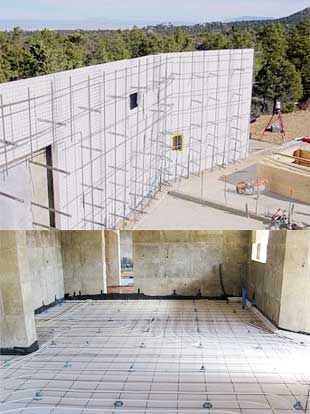Poured Earth Homes
More people today are becoming interested in poured earth homes.
These houses are Eco-friendly and there are always plenty pf places
to find the necessary building materials. The materials used in
traditional home-building are not as safe from toxins as poured
earth. This is one earthen type of construction that is enjoying
popularity.

Poured Earth Homes |
|
Poured earth is not mud, it is actually more than that. It is
similar to concrete, in that you use dry cement along with an
aggregate for binding the materials together. Poured earth homes
use soil instead of gravel or sand as the aggregate that you mix
with concrete.
The soil you select for your structures that will be poured needs
to be tested to determine if it meets the requirements. If your
soil is not ideal, you can add things like magnesium oxide or
lyme, to make your available soil correct to use. Once it's more
compatible, you can determine the amount of cement needed to mix
with the soil for your house.
In addition to the materials, you will need a way to pour them,
like a concrete pump or a cement mixer. These can often be rented
or borrowed from construction companies. If you need to hire someone
to pour your house, that company will probably already have a
cement mixer to use. You will also need wood or steel & concrete
frames that will hold the poured earth as it dries, and becomes
your walls. In addition, some finishing material is necessary
for the outdoor and indoor walls.
Poured earth homes usually cost about the same build than do
traditional houses, but they can also run a little higher. Until
they become more widespread, they are considered customized buildings,
making their construction costs slightly higher. But these houses
are cheaper to maintain and are energy efficient and the costs
will go down, as companies develop more standard types of poured
earth houses.
Pour It On ...
Poured earth homes are very durable, much like concrete buildings.
They are quiet inside since the walls are thick, and there are
no chemically treated woods, insulation or other building materials
that contain toxic elements. These houses are low-maintenance
buildings, able to resist some of the everyday wear and tear that
all homes face.

Cooling or heating your home is also easier, since the walls
retain ambient temperatures. This makes it easier to maintain
a consistent indoor temperature. The construction of these houses
is quite speedy as well, especially compared to conventional homes
which can bring down the labor costs involved in these dwellings.
Once you have a foundation in place, you will erect the frames
and fill them with your mixture of poured earth. You can add spaces
between dual walls as well, for better insulation. After the earth
has set and cured, the walls can be finished with a mix of straw
and mud, or with plaster. You can paint the walls, inside and
out, any way you want them.
Conclusion
Poured earth homes are similar to concrete houses, in the way
they are made and poured, but the soil you utilize makes it more
economical to mix and pour. You need almost no maintenance for
walls of poured earth, and they resist the aging effects of rain
and sun.
|

